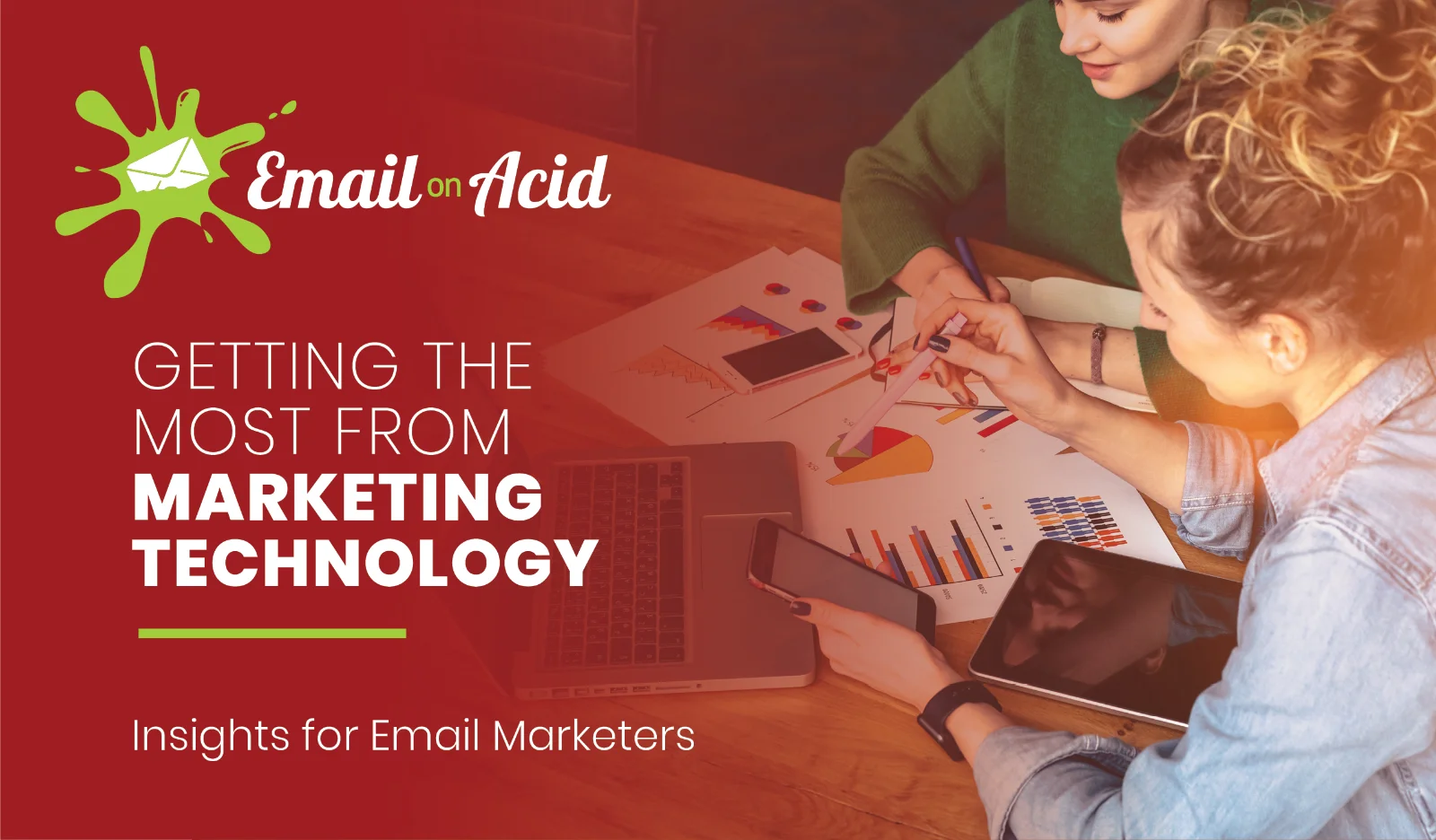Email Marketing
B2B Email Automation: 13 Campaign Ideas for Customers and Leads
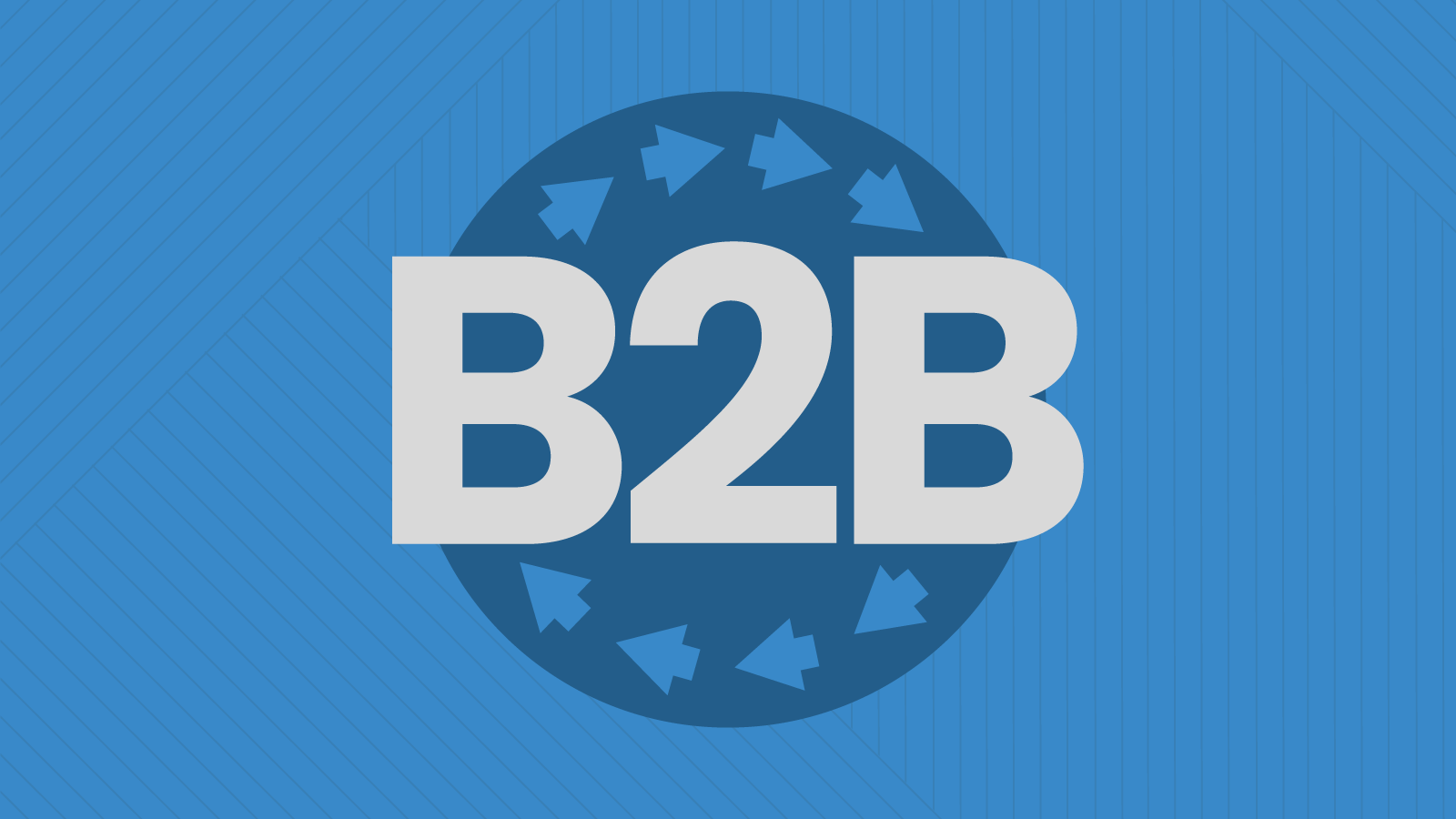
Email Marketing

Many B2B organizations have long sales cycles. For this reason, nurturing and following up with leads, prospects, and customers is one of your most important marketing tasks. B2B email automation makes your efforts easier, more effective, and less time-consuming. It supports and amplifies the work of your sales team, warming up leads and nurturing customers.
However, in our survey on email marketing with Holistic, we found 58% of companies are using just one to five email automations. To be clear, more than half the companies in the study have two to five people on their email teams.
So these organizations understand the importance of email marketing, but they may be underutilizing B2B email marketing automation.
Automated email nurture campaigns allow you to consistently follow up and stay on the minds of key players who have a role in the buying process. When they’re ready to make a buying decision, you want them to come to you. That happens more often when you’ve put in the work of nurturing and building a productive, two-way relationship in which you’ve provided value, demonstrated expertise, and shown professionalism.
Of course, automated B2B email campaigns are also important after someone closes the deal or a purchase is made. They are crucial for onboarding, retention, and upselling.
Here are 13 different types of B2B email automation to consider for your strategy.
A welcome email series is your first opportunity to endear new leads, prospects, and customers to your company. You can send this series out in a variety of situations, including when someone makes a new purchase, fills out a form for gated content, joins your email list, attends an event, or takes another action. It’s a general welcome to your brand.
A welcome series doesn’t need to be a set length. You might send a single email, or several might work better. Test to see what works best for your company. An email welcome series represents an opportunity to:
Which of these you prioritize, and in which email of the series, depends on a variety of factors specific to your business and goals. But a good welcome series will do as many of these as possible.
They say to put your best foot forward, and that’s exactly what brand asset management tool Niice does in its automated welcome series. The email includes a friendly welcome video and encourages new subscribers to explore the features and the benefits of the product using helpful content.

If you’re selling software services, sending emails to the chief technology officers at companies with 100 or more employees will be far more effective than sending them to your entire list.
Why? Because you can speak directly to their needs, interests, and concerns. You can speak their language, show them how well you understand their situation, and earn their trust.
This is why it’s so important to create email segments, or sub-lists, within your overall email list. You may not know a subscriber’s title or specific job function, but you can still segment them into a relevant group by things like the particular landing page that persuaded them to join your list or the specific lead magnet they downloaded.
Check out how NewsCred (which has since rebranded as Welcome) curated specific content in this email that’s meant for C-suite executives.
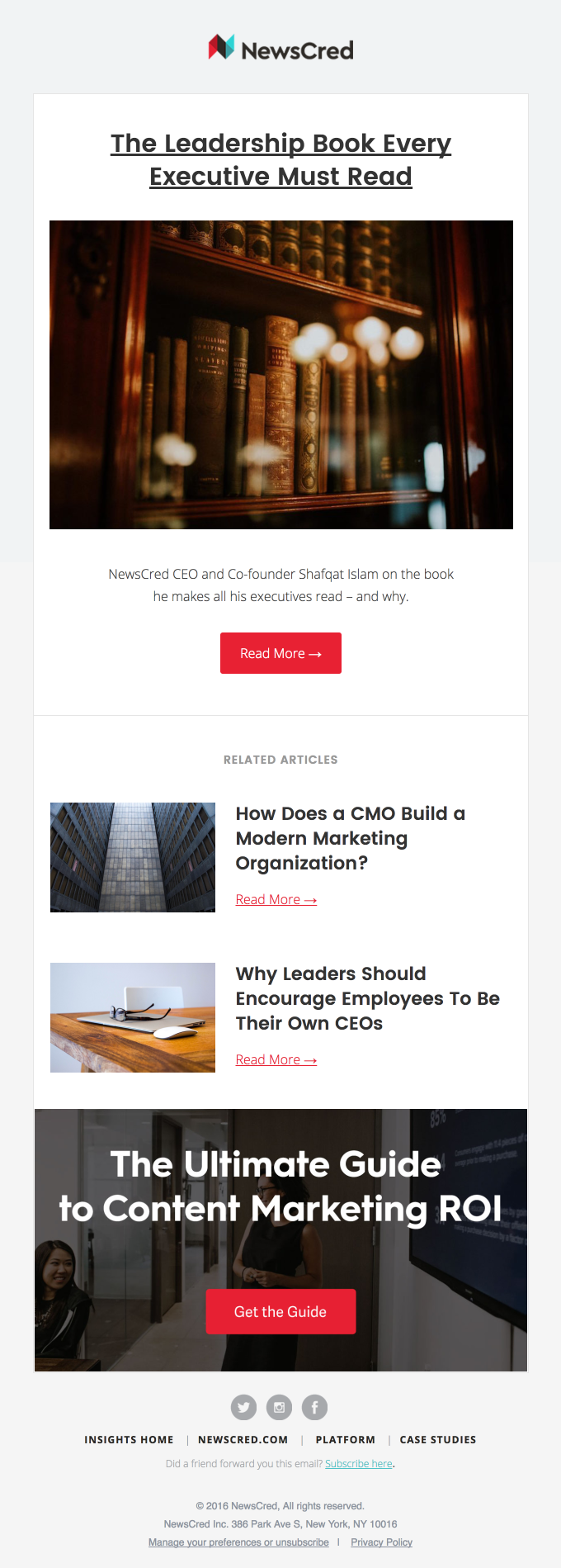
Personas are particularly powerful tools when used well. Get more info on how to use buyer personas in your email marketing.
Suppose your company manufactures HVAC equipment. You could be selling to home builders, commercial venues of all sorts, and government offices, in addition to the HVAC installers and contractors who serve those industries. Each of these has very different needs, preferences, and pain points.
MarketingSherpa determined that irrelevant content is the second-highest cause of unsubscribes. But if you know what your readers are interested in, you can eliminate this problem long enough to add value to their day and demonstrate how your products or services meet their needs.
In our HVAC example, home builders likely have the expertise to make a decision about the specific kinds of equipment they need. But they might benefit from information on how to maximize installation efficiency and implement quality control measures on a large scale. Meanwhile, local HVAC installers will appreciate materials that help them explain and sell different kinds of systems to homeowners.
A lot of content these days borrows from other content. And that’s a perfectly fine strategy. But originating new content helps prospects view you with more authority and expertise.
As part of a thought leadership series, your messages should be less about “how-to” and more about the “why” behind trends, changes, or standards related to your industry. It often makes sense to portray your company’s leadership as the originator of thought leadership content instead of the marketing team. You want to demonstrate that company leaders are on the cutting edge and that their wisdom extends throughout the entire organization.
While original thought leadership is best, you can “borrow” some authority by featuring well-respected individuals within your content. If the industry’s most recognized leader is willing to do a “sit down” with an executive at your company, it implies a vote of confidence that you must be doing something right.
Remember, thought leadership is often about timing and relevancy. You can’t be a leader if you’re late to adopt and promote the idea. So these kinds of B2B email automations need to be updated frequently and aligned with the customer journey.
What happens after you demo your product? What do your prospects hear next? Often, you’re doing the demo for end-users rather than the decision-maker. Even if you are working with a decision-maker, they may still need to go run the numbers or consult with others on their team.
What does that mean for you? It means they’ve become your chief salesperson. But are they equipped?
It’s your job to ‘train’ them, and you can do that with a follow-up email series. Restate your benefits. Show your value. Share testimonials. Show outcomes. Give data. Address common objections and misconceptions. Give them the substance they can use to ‘sell’ their teams on your system.
Here’s how SalesForce followed up with contacts acquired at a live event in 2018.
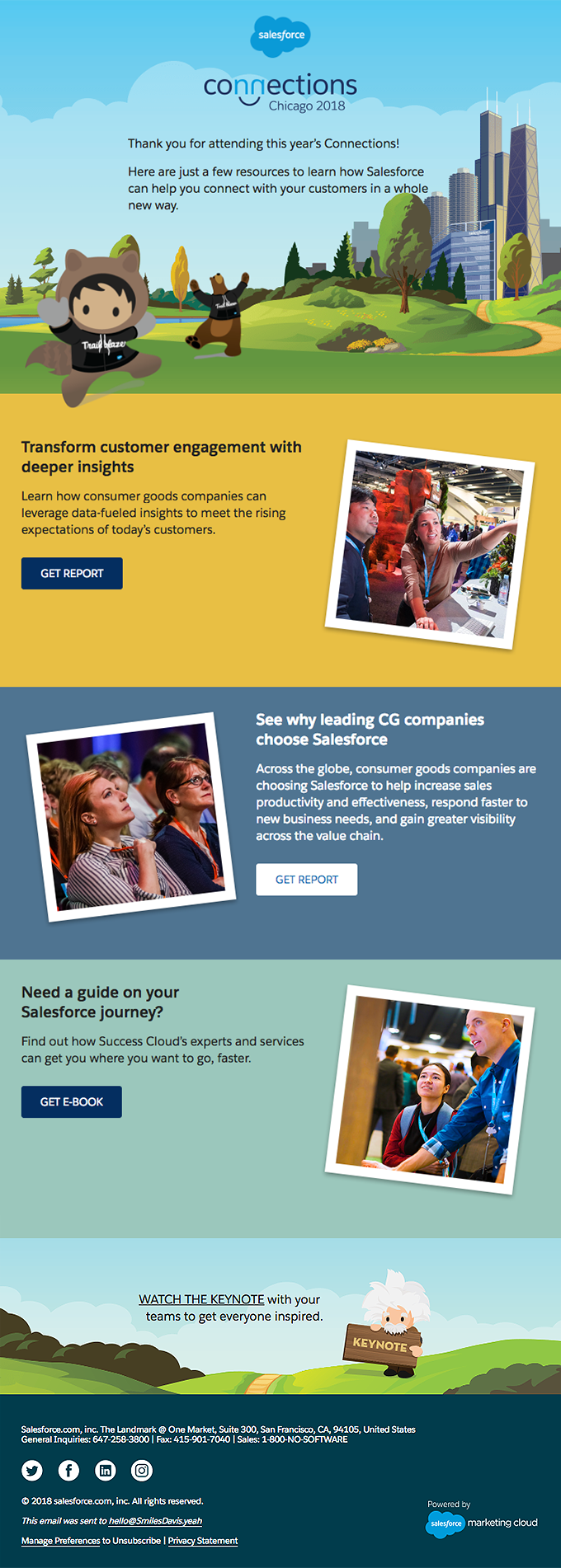
After someone makes a purchase, don’t stop communicating with them via email. You want them to be successful so they get the most out of your products and services. Sometimes effective adoption of a new product requires a little training and education.
For that, you can develop an onboarding email series. This might include:
HubSpot’s onboarding email keeps the excitement high and prompts subscribers to continue down the onboarding path. The message presents a series of checklist-like items to get started on the platform while the headlines reiterate the key selling points of the program. Plus, there are plenty of options for readers to explore their favorite elements and an upsell CTA at the end.

For live and virtual events, which can include tradeshows, conferences, and webinars, you have several challenges.
First, you need people to come, including the ones who signed up. No-show rates, particularly for webinars, can run very high.
Second, you need them to be excited about the event. You want them looking forward to it. Anticipating it. Not dreading it or looking for a way to get out.
Third, you need to follow up afterward. Far more sales are made after events than at them. The ROI from events is in the follow-up.
All three of these challenges can be hit head-on with a high-powered event marketing series that begins well before the event, and continues after it’s over.
In this series, you want to re-state benefits and promise powerful outcomes and rewards. As the event gets closer, spell out the logistics: How to attend, where to go, where to click, deadlines for early bird discounts, special offers for free gifts, and last-minute reminders to attend.

This post-event email from Campaign Monitor was crafted specifically for the no-shows. Though not as impactful as actually attending, an automated email series just for those who missed the show can help you extract as much value as possible from your efforts.
These are straight-up sales emails. But if your subscribers are excited about what you sell, that’s not a problem. Think of how people geek-out over the latest release from Apple.
Use B2B email automation for product launches to build anticipation and accept pre-orders. You should also automate email marketing upsells, which nudge customers towards high plans or better products. Highlight the benefits of premium features and motivate people with exclusive promotions.
Different emails should touch on different aspects of making the sale. Use testimonials and explain the research behind the new product, the unmet need it was designed for, the outcome it will produce for the customer, why their bosses will like it, and the actual sales offer.
Designmodo presents their new product in three different ways that still prevent the copy from becoming redundant. This kind of flexibility lets subscribers choose their own path forward and can increase engagement rates. They offer a video, then a written description as well as an (incomplete) bullet point list that’s designed for click-throughs. And, of course, there are multiple opportunities for readers to jump ship and buy right away.

How do you build better B2B email list segments? Send out surveys.
You may want to gather feedback at certain points in the customer journey. What did they think of the onboarding experience? How do they feel 90 days, six months, or a year after signing with you? Could your company better serve their needs moving forward?
Timing is everything. Triggering emails with customer surveys based on specific actions and time periods means you get the right feedback from the right people.
Explain why the survey matters and how subscribers will be helping when they fill it out. You might throw in a perk like a sweepstakes entry, special gift, or discount on future purchases. Survey campaigns should also have a deadline. Build your campaign around that date, and include some reminder emails.
Surveys are great for gathering valuable feedback about your company and product performance in a variety of key areas. When you can pinpoint your customers’ most pressing frustrations, you can more accurately allocate your budget to make the biggest gains.
Once you have a customer, you want to keep them. You can lose them to competitors, but you can also lose them to ‘nothingness’ – apathy. They may still be on your list, but they’ve moved on in their minds.
The best way to prevent that from happening is to delight them.
Be proactive and create a few B2B email automation campaigns every year that make special offers, time-limited discounts, or opportunities for exclusive access to something like a sneak peek at a new product or experience. Making your customers feel special and wanted — like a VIP — is a great way to increase their loyalty.
You can also keep the positive feelings flowing by using testimonials and case studies that reaffirm how much of a difference you’re making in your customers’ businesses.
And, continue being helpful and relevant by sending timely tips, how-to videos, and content that targets their needs.
If your company uses a subscription or membership revenue model, renewals are your bread and butter. How you approach renewals depends on whether subscriptions renew automatically or manually.
If automatic, then a retention campaign is more appropriate. If manual, such as an annual purchase of a software license or the use of a service, this email series should focus on all the value clients receive. It could also include a survey that asks for feedback about how you can do better. If someone indicates dissatisfaction in specific areas, this might even trigger an additional email about upcoming, related product improvements.
This series should do more than just beat them over the head with warnings about how their subscription is about to expire. You need some of that, but you’ll get better results if you show appreciation and deliver value.

Though it might look like a standard renewal email, this one from Namecheap particularly effective because it presents a special, discounted offer, suggests additional and alternative purchases the customer can make, and creates urgency by placing a deadline on the deals.
Some customers haven’t bought anything for a while, or they’ve been on your list but have stopped interacting with your emails. If you sell a service, you might notice they’ve stopped using what they bought. If it’s a subscription service, you need a B2B email automation campaign to find out if something’s wrong and determine how you can remain relevant to their business.
Sometimes, this can be an opportunity to both remind subscribers about your product and nudge them toward an even better option. Check out how Grammarly looks to reactivate and reengage customers with this email.
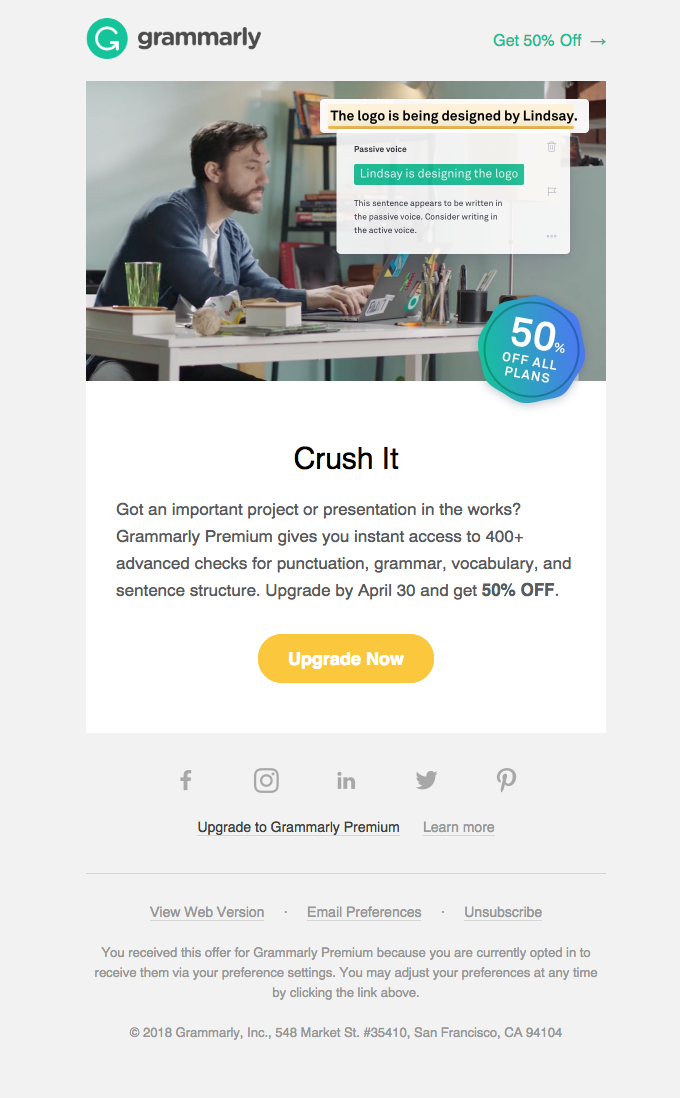
Reengagement campaigns can also include:
B2B companies are often working with pricey services and there’s a lot of trust involved in picking the right vendors and solutions. A little gratitude goes a long way. Consider more than just a one-time “thank you” email.
This campaign works especially well on anniversaries: when someone first became a customer, or right after they renew their subscription. Your automated thank you campaign can offer things like rewards, special gifts, exclusive invites, special videos, and photos – be creative here. Just make sure that it feels sincere and personal.
Check out the engaging way FontShop thanked new subscribers for signing up for its email newsletter. It’s more than a thank you, it builds anticipation for what’s to come, meaning those newsletters are unlikely to be ignored.

The last thing you want, after spending all the effort creating email automation campaigns, is for your messages to fall flat. Low email open rates, bad links, sloppy typos, illegible text, or wonky graphics can all spell doom for even the best of intentions.
Email on Acid helps companies create error-free emails with maximum efficiency. This means that every email you send looks perfect in every inbox and to every person reading them.
A trap email teams fall into is that, because they make use of templates, they don’t need to test those campaigns on a regular basis. The email world, however, is constantly evolving. You never know when a client will start rendering your campaigns differently. You never know when content may get removed from your site. And you never know when your B2B email automation campaigns could start ending up in spam folders.
Email on Acid can help with all those unknowns and more. Use our email readiness platform to test every B2B email automation on a regular basis so you’re always delivering email perfection.
Determining what email marketing solutions belong in your Martech stack can be challenging. So how do you know what tools are right for your team?
In our whitepaper, Getting the Most from Marketing Technology, we explore three questions related to assessing new marketing technologies:
You’ll see survey data from marketing leaders as well as revealing insights and takeaways that will help you develop a process for assessing marketing technology like Email on Acid. Then you’ll have a better framework for deciding if and when new marketing technology is right for your company.
